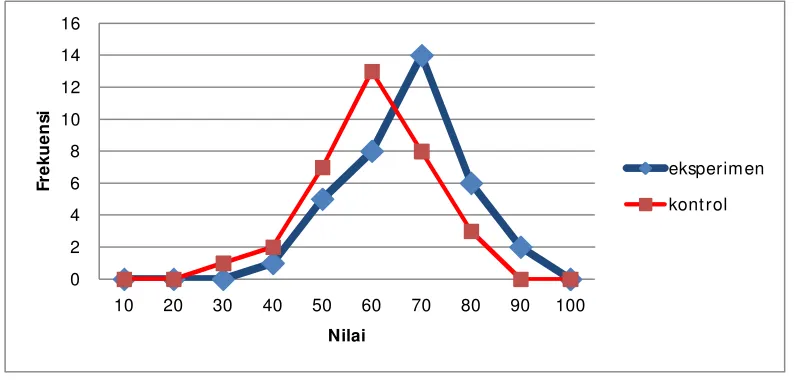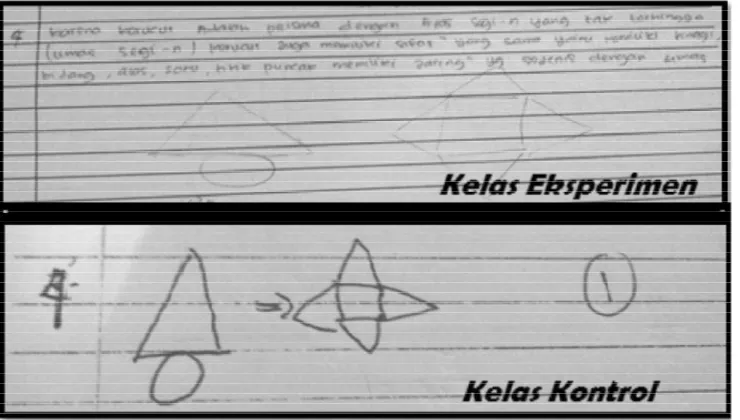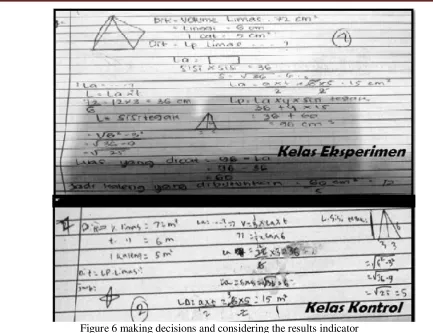M – 33
THE EFFECT OF MEDIA-ASSISTED GUIDED DISCOVERY METHOD OF
CONCRETE OBJECTS TO MATHEMATICAL CRITICAL THINKING
ABILITY
Khairunnisa*, Ghufron Kamil, Kadir
Universitas Islam Negeri Syarif Hidayatullah Jakarta email: [email protected]
Abstract
The purpose of this study was to describe the effect of media-assisted guided discovery method of concrete objects on students’ mathematical critical thinking. This research was conducted at SMP Darul Maarif in South Jakarta, Academic Year 2013/2014. The method used was a quasi-experimental with Control Group Post-test Only Design. The sample was 70 students which taken cluster randomly. Data of the research were collected through the test. Of the students’ mathematical critical thinking ability. The hypothesis of the research was tested by using t-test. The results showed that the students’ mathematical critical thinking abilities were taught by guided discovery learning methods aided concrete media objects is higher than students were taught by conventional teaching methods (of t = 2.40 and t-table = 2.00 ). It can be seen from the results percentage from each indicators whcih covers: For , the indicator which focussed on questions of the experimental class reached 78.7%, while the controlled class reached 61.76%. Argument analysis indicator of the experimental class reached 66.2%, while the controlled class 47.55 %. In answering the questions which being supported by argument of the experimental class reached 61.11%,while 48.53% in the control classes. For the indicators in making decisions and considering the results of the experimental class reached 76.59%, while the controlled class 70.59%. Based on the research results, it can be drawn conclusion that mathematical instruction on the subject matter of flat figures using media-assisted guided discovery method of concrete objects significantly affected on students' mathematical critical thinking ability.
Key word: mathematical critical thinking, media-assisted, guided discovery
Introduction
One the problems which facing by Indonesian education world is the lack of students thinking ability. Because of the learning process did not improving this ability (Sanjaya, 2010). Indonesian students' mathematical ability for non-routine problems very weak, but relatively good in solving problems of the facts and procedural (2011). According to Poedjiadi (Karim, 2010)"critical thinking be a provision for students to face the world level competition". Changing Era along with the change of human civilization requires a mindset that is capable of searching and analyzing the information to resolve the problem. As more modern, increasingly tight competition among individuals as well. To that end critical thinking abilities are very important to be trained and developed.
There are several groups of critical thinking abilities, one of them according to the Ennis. He was classifying critical thinking abilities into five abilities: 1. elementary clarification, 2. basic support, 3. inferring, 4. advanced clarification, 5. strategies and tactics (Dina,2009).
0
method of concrete objects. The benefit of the study is provide an overview of the influence of guided discovery method of critical thinking abilities of students in the learning of mathematics.
Research method
This research is a quasi-experimental with the post-test only control group design. The population was Darul Maarif junior high school students of class VIII even semester at the Academic Year 2013/2014 which consists of 6 classes. Two classes were taken randomly as research samples. One class as an experimental class using media-assisted guided discovery method of concrete objects and other class as control using conventional method. The instrument used was students’ Mathematical Critical Thinking Ability test. Data were analyzed using t-test.
Results
Student’ Critical thinking abilities test results for subject matter of geometry flat sides from the experimental class and conventional class, shown in the following table:
Statistik Experimental class Control Class
Number of sample 36 34
Standard Deviance 12,61 11,39
Slope -0,66 0,12
Table 1. Data Description of Mathematical Critical Thinking Ability from experimental class and control class
From the table we can see that mathematical critical thinking ability from experimental class is higher than conventional class. Experiment group data accumulate above the mean, whereas in the control group the data tendency to accumulate below the mean. Visually, the difference in the two groups of data dissemination can be seen in the picture below:
Figrure 2. Percentage Comparison of Students’ Mathematical Critical Thinking Ability of Experimental and Control Class
In Figure 2 showed that the percentage on each indicator of student’s mathematical critical thinking in the experimental class scored higher than the control class. The highest percentage was achieved by thinking indicators focussed on questions; the percentage was achieved by the experimental class is of 78.47% while the lowest percentage was obtained with the control group is 47.55% for the indicator to analyze arguments
Discussion
Differences in the ability to think critically of flat figure geometry in this study also reflected in the results of the posttest answer which was different between the experimental class and the control class. Here is the analysis of the results of the test answers of flat figure geometry critical thinking ability based on the indicators:
a. Focussed on question
Indikor focussed on question is to measure students' ability to identify and formulate problems, and also to consider other possibilities that can be an alternative to solve the problem. As a general overview of the results of research on flat figure geometry critical thinking ability indicators focussed on questions will be displayed along with the answers with students’ posttest experimental class and control class. One of the results of the students’ answers to question number one is as follows :
Note the picture ABCD.EFGH cube.
Through its vertices are drawn diagonal lines, so it becomes pyramid-shaped.
a. How many pyramids are formed in the cube? Mention! b. Are the pyramids congruent?
c. What is the base of each pyramid shaped?
d. If the length of the rib cubes 8 cm, specify the height of the pyramid
Figure 3. Answers of Student Focussed on Question Indicator from Experimental and Control Class
From the result above can be seen that the answers to the posttest of experimental class students is better than students in the control class. This is because the answer of experimental class students' mathematical critical thinking skills is more visible than the control class. The reason is that the experimental class students are able to understand the issues well, so they can more focus in viewing the pyramids which are in the cube. In the experimental class, they have been able to identify many of the quadrilateral pyramids contained in the cube, i.e. there are 6 pieces of quadrilateral pyramid while in the control class, they have not been able to identify many of the quadrilateral pyramid contained in the cube.
b. Critical Thinking Skills of Arguments Analyzing Indicator
Indicator of flat side geometry arguments analyzing indicator that measures students' ability to identify the reasons stated and to look for similarities and differences in problem solving. In this indicator, they are given an argument, then the students analyze the arguments given. One of the results of the students' answers to the question number four as follows: If the cone is said to be a pyramid with a circular base field. Investigate why the cone can be said to be a pyramid whose base is circle-shaped?
The difference in response of the experimental and control classes are presented in the following figure:
Figure 4 Student Answer on Argument analysis indicator
c. answering the questions which being supported by argument Indicator answering the questions which being supported by argument indicators which is to measure students 'ability in giving the arguments for the statemen in the question which causes the student give different statement. The following will be displayed question / problems with the student’s posttest answer of experimental and control classes. One of the results of the students' answers to the question as follows:
Shakir wants to frame beam with a length of 6m, 4m width and 2m height. If Shakir is given 100 meter long wire, Shakir can make beam frame more than 3. Is this correct? Give reasons! The difference in response of the experimental and control classes are presented in the following figure:
Figure 5. Answering the questions which being supported by argument indicator
In the experimental class, students opposed to that statement in question is not true, and students give reasons for what he resisted. While in the control class in figure 5, students only present the facts, without any arguments against the existing statement in the matter.
d. making decisions and considering the results Indicators
Indicators of making decisions and considering the results measure students' ability to apply the principles needed to solve a given problem. This indicator measures the extent of how far student can apply the principles to find solutions of a given problem.
The following will be displayed the question / problems and student’s posttest answer of experimental and control classes. One of the results of the students' answers to the question number seven as follows:
Figure 6 making decisions and considering the results indicator
Based on figure 6 can be seen that students are able to apply the needed principles to answer the question. In the experimental class, students learn the sequence to solve problems. While in the control class, students are not able to determine the next step so matter can be resolved properly.
The results Obtained compared with other research relevant by Asrul Karim (2011) ". One ability of critical thinking which is measured is to give a simple explanation. Just as his research, this study also measures critical thinking ability of giving a simpler explanation. However, in his study is to measure analyzed algorithm indicator but in this study, measuring the indicators analyze arguments. Although both indicators are different, but the same ability measured, which gives a simple explanation. The results are both indicators are better given a lesson by using the guided method discovery than conventional learning.
Conclusion and Suggestion.
Based on the research results and discussion obtained conclusion the use of media-assisted guided discovery method of concrete objects give effect to students' mathematical critical thinking ability than conventional methods
The following are some suggestions based on this research:
1. Further research might examine other indicators of critical thinking abilities who have not been examined in this study such as identifying assumptions, decide a course of action, consider the credibility of a source, and make deductions and consider the results of deduction
Bibliography
Arief dkk. (1996). Media Pendidikan. Jakarta: PT Raja Grafindo Persada.
Arikunto, Suharsimi. (2012). Dasar-dasar Evaluasi Pendidikan. Jakarta: Bumi Aksara, 2nd Edition, First printing.
Arikunto, Suharsimi. (2006). Dasar-dasar Evaluasi Pendidikan. Jakarta: Bumi Aksara, Revised Edition, 6th printing.
Arsyad, Azhar. (2011). Media Pembelajaran.Jakarta: Rajawali Pers.
Dahar, Ratna Wilis. (2006). Teori-Teori Belajar dan Pembelajaran. Jakarta: Penerbit Erlangga.
Ismaimuza, Dasa. (2011). “Kemampuan Berpikir Kritis Matematis Ditinjau dari Pengetahuan
Awal Siswa”. Jurnal Pendidikan Matematika, Volume. 2, January.
Johnson, Elaine B. (2010). Contextual Teaching & Learning. Bandung: Kaifa Learning.
Kadir. (2010). Statistika Untuk Penelitian Ilmu-Ilmu Sosial. Jakarta: Rosemata Sampurna.
Karim, Abdul. (2010). “Meningkatkan Kemampuan Penalaran dan Berpikir Kritis Matematis
Siswa SMP Melalui Pembelajaran Model Reciprocal Teaching”. Jurnal Ilmu Pendidikan,
Volume. 3,.
Karim, Asrul. (2011 ). “Penerapan Metode Penemuan Terbimbing Dalam Pembelajaran Matematika untuk Meningkatkan Pemahaman Konsep dan Kemampuan Berpikir Kritis Siswa Sekolah Dasar”. Jurnal ISSN 1412-565X, Edisi Khusus No.1, Agustus.
Markaban. (2006). Model Pembelajaran Matematika Dengan Pendekatan Penemuan
Terbimbing. Yogyakarta: DEPDIKNAS.
Margono, S. (2010). Metodologi Penelitian Pendidikan. Jakarta : Rineka Cipta.
Lawshe, C. H (1975), A Quantitative Approach to Content Validity. Personnel Psychology, INC.
Ruseffendi. (1988). Pengajaran Matematika Modern dan Masa Kini. Bandung: Tarsito.
Sanjaya, Wina. (2006). Strategi Pembelajaran Berorientasi Standar Proses Pendidikan. Bandung: Kencana.
Sumarmo, Utari. (2010). Berpikir dan Disposisi Matematik serta pembelajarannya. FPMIPA UPI: January.
Suwarma, Dina Mayadiana. (2009). Kemampuan Berpikir Kritis Matematika. Jakarta: Cakrawala Maha Karya.
Syamsuduha, Dodi. (2010). “Pengaruh Pembelajaran Kooperatif Berbantuan Goemeter’s
Sketchpad Terhadap Peningkatan Kemampuan Berpikir Kritis Matematik Siswa SMP”.
Yamin, Martinis. (2004). Strategi Pembelajaran Berbasis Kompetensi. Jakarta: Gaung Persada Press.


